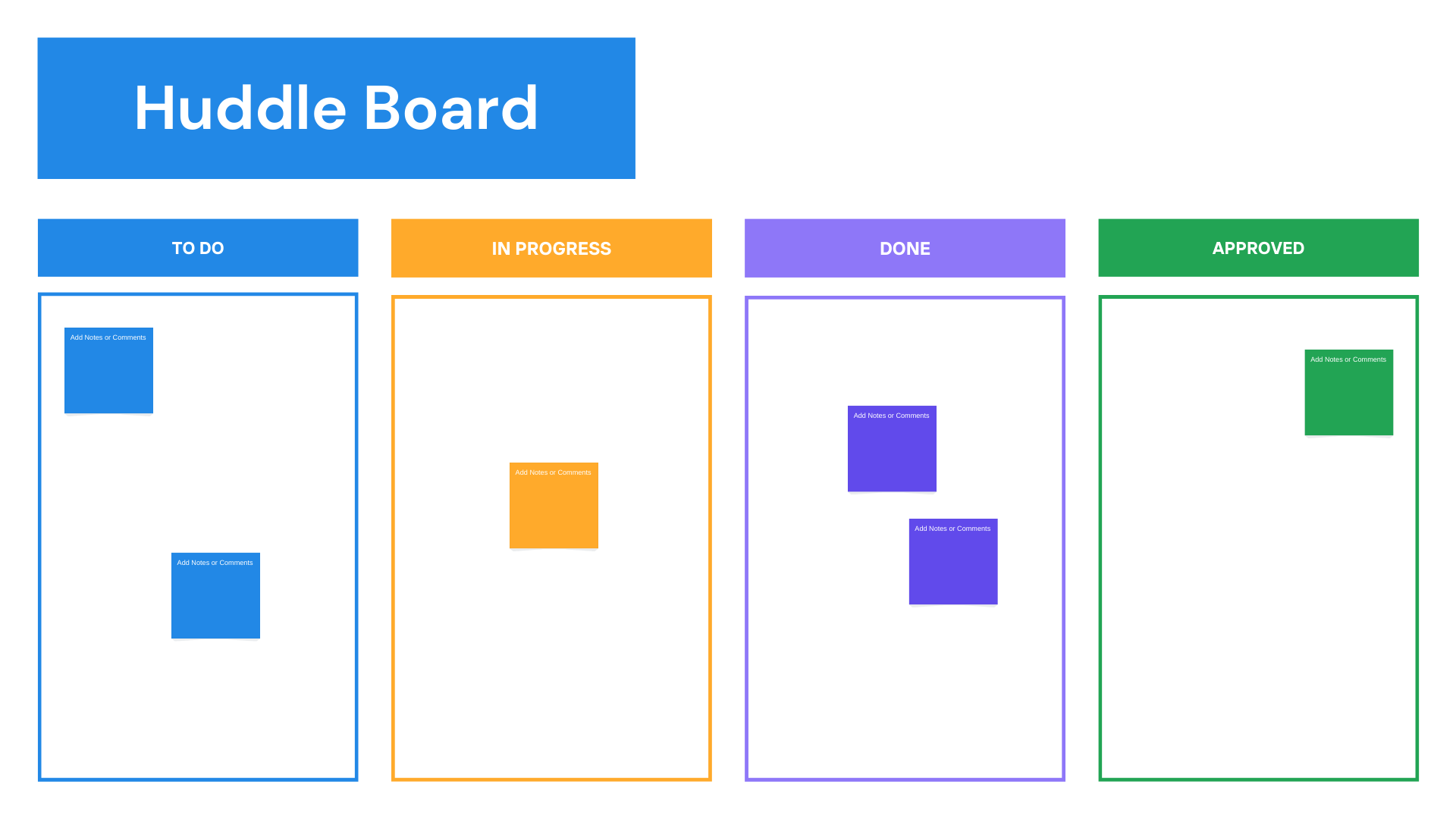A huddle board is a visual management tool used in team environments to facilitate quick, focused, and productive meetings known as huddles. These boards help teams to communicate effectively, monitor progress, identify issues, and plan actions. Here’s a detailed explanation of the components, benefits, and best practices for using a huddle board:

Components of a Huddle Board:
Daily Tasks/To-Do List:
Lists the tasks or activities to be completed within a day or a specified period.
Progress Tracking:
Visual representation of the current status of tasks or projects.
Key Performance Indicators (KPIs):
Displays the metrics that are critical to the team's success and performance.
Issue Tracking/Problem Solving:
Highlights issues or blockers that need to be addressed by the team.
Achievements/Celebrations:
Acknowledges and celebrates team successes and milestones.
Upcoming Events/Deadlines:
Keeps the team informed about important upcoming dates, meetings, or deadlines.
Benefits of a Huddle Board:
Improved communication and collaboration among team members.
Increased transparency and visibility of work progress and priorities.
Quick identification and resolution of issues or blockers.
Enhanced team morale and motivation through recognition of achievements.
Facilitates alignment of team goals and priorities.
What is a virtual huddle board?
A virtual huddle board is an online or digital version of a traditional huddle board. It is used by teams to track tasks, progress, KPIs, issues, and events in a virtual or remote work setting. Virtual huddle boards typically include features such as real-time updates, digital sticky notes, color-coding, and collaboration tools to facilitate communication and coordination among team members who are not physically located in the same place. They serve the same purpose as traditional huddle boards but are accessible from anywhere with an internet connection, making them ideal for distributed teams or remote work environments.
What is the purpose of the huddle?
The purpose of a huddle is to facilitate quick, focused team meetings that enhance communication, coordination, and problem-solving. It allows team members to share status updates, identify and address issues, align efforts, and hold each other accountable. Huddles also boost morale by recognizing achievements and fostering a sense of teamwork.
How to use huddle board?
To use a huddle board, start by setting up sections for tasks, progress, issues, KPIs, and upcoming events. Update the board regularly to reflect the latest information. During daily standups, review each section to track task status, identify blockers, and discuss plans. Use visual aids for clarity, encourage team participation, and focus on actionable items.
Huddle Board
What is a Huddle Board?
A Huddle Board is a visual tool used by teams to track key performance indicators, discuss daily goals, and align on priorities. It is commonly used during brief, regular meetings or "huddles" to improve communication and performance.

How does a Huddle Board work?
Teams gather around the Huddle Board to discuss current performance metrics, identify issues, and plan improvements. This board provides a focal point for updates and aligns the team on short-term goals and actions.
What are the primary elements of a Huddle Board?
A Huddle Board typically includes sections for performance metrics, key tasks or goals, ongoing challenges, and action items. These elements vary based on team needs and operational priorities.
What are the benefits of using a Huddle Board?
Huddle Boards improve visibility into team performance, foster accountability, enhance communication, and enable quick decision-making, helping teams stay aligned and focused on key goals.
How often should teams use a Huddle Board?
Teams typically review the Huddle Board daily or weekly during brief "huddle" meetings, allowing for frequent updates on progress, challenges, and priorities.
What types of organizations benefit from Huddle Boards?
Huddle Boards are valuable across industries, including manufacturing, healthcare, and services, where regular performance updates, goal alignment, and team coordination are critical.
Can Huddle Boards be customized for different teams?
Yes, Huddle Boards can be customized with specific metrics, categories, and goals to suit each team’s unique needs, enhancing relevance and effectiveness in tracking progress.
How does a Huddle Board improve team communication?
Huddle Boards centralize key information and foster regular discussions, making it easier for team members to communicate priorities, share updates, and address issues collaboratively.
Can a Huddle Board be used for remote teams?
Yes, digital Huddle Boards are ideal for remote teams, allowing members to access updates, participate in virtual huddles, and stay aligned on goals and progress regardless of location.
What challenges can arise in using a Huddle Board?
Challenges include maintaining accurate updates, engaging all team members, and ensuring consistent use. Clear guidelines and team commitment can help overcome these challenges.
How does a Huddle Board support continuous improvement?
Huddle Boards enable continuous improvement by highlighting performance metrics, identifying areas for enhancement, and promoting regular action on issues through collaborative problem-solving.
How are performance metrics tracked on a Huddle Board?
Teams update performance metrics on the Huddle Board based on data from recent tasks or projects. Visual indicators are often used to signal progress, trends, and areas needing attention.
What is the difference between a Huddle Board and a Kanban Board?
While a Huddle Board focuses on overall team performance and key metrics, a Kanban Board is more task-oriented, visualizing the flow of individual tasks through stages to completion.
Can Huddle Boards be digitalized?
Yes, digital Huddle Boards offer advantages like real-time updates, remote access, and data visualization, making it easier to manage and share performance insights among dispersed teams.
How can an organization get started with a Huddle Board?
Organizations can start by defining relevant metrics, setting up a board with clear sections, training teams on its use, and scheduling regular huddles to review performance and address goals.